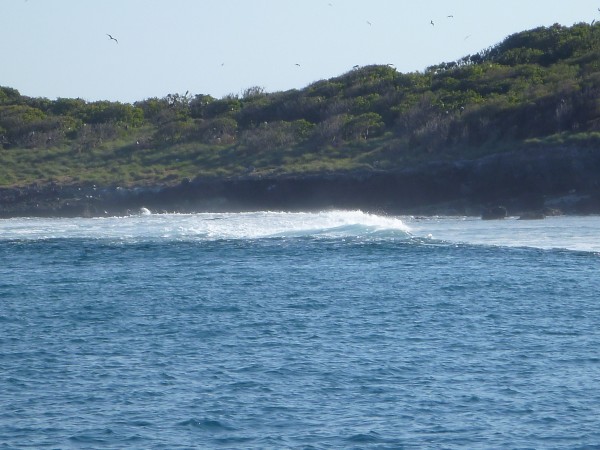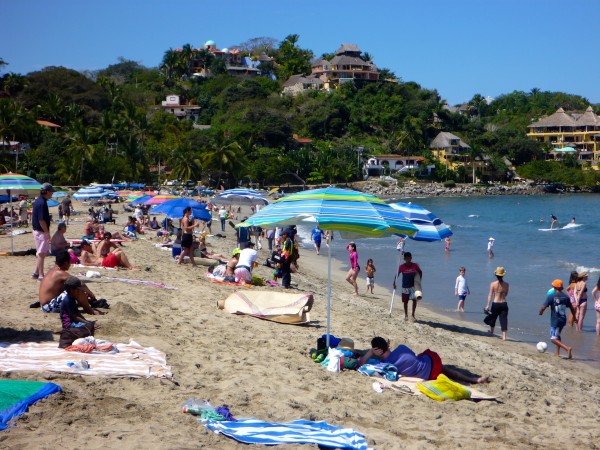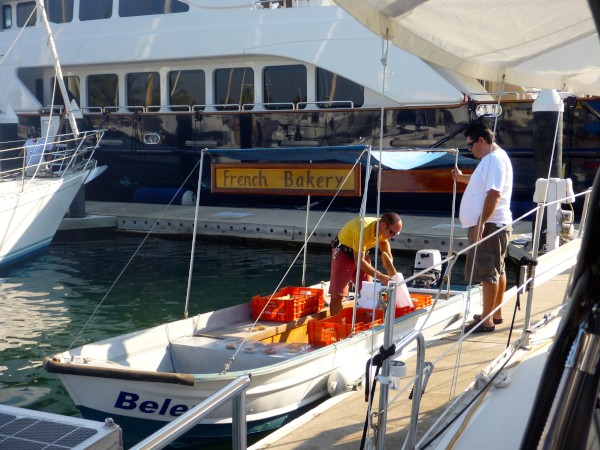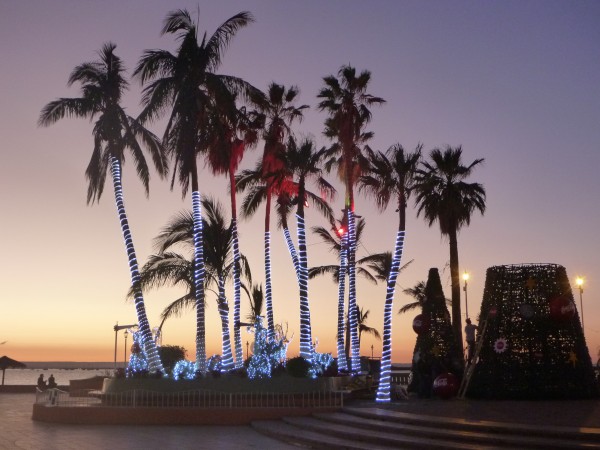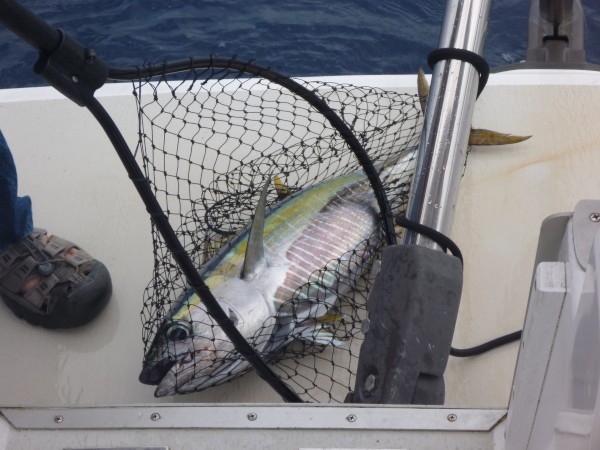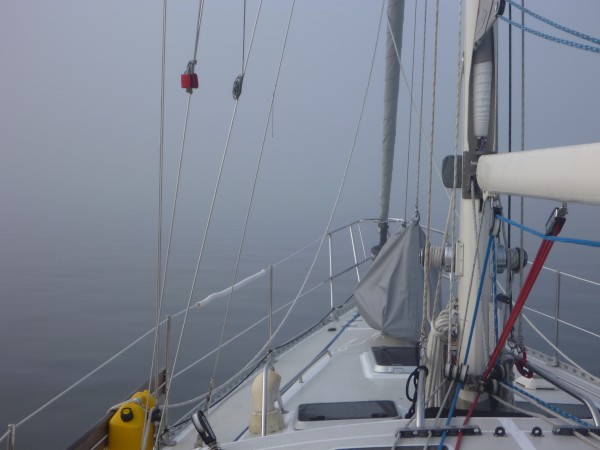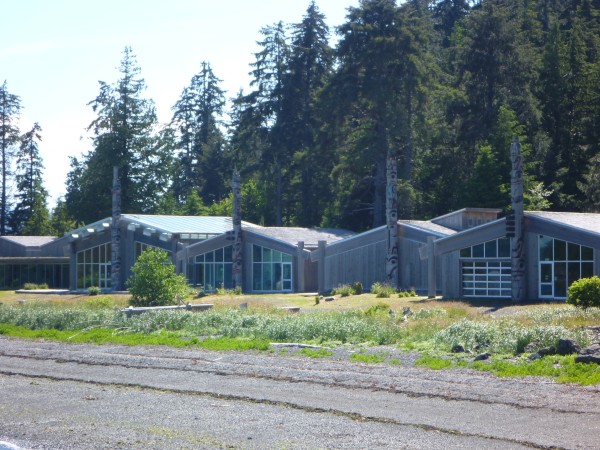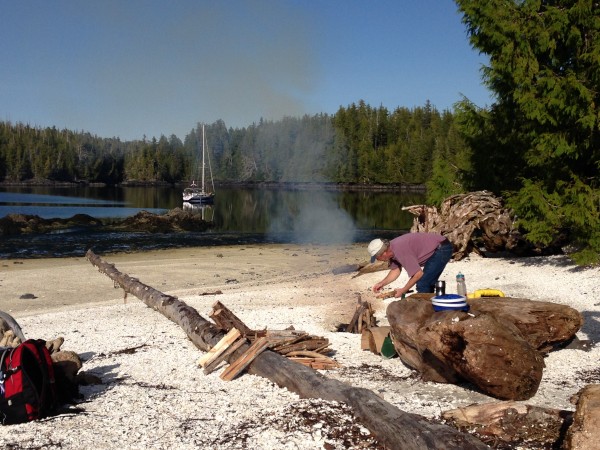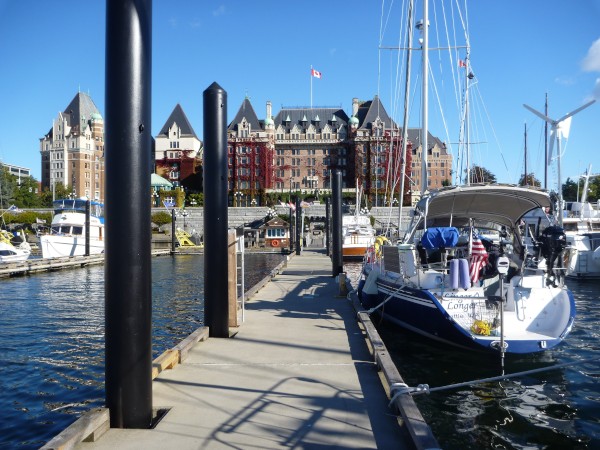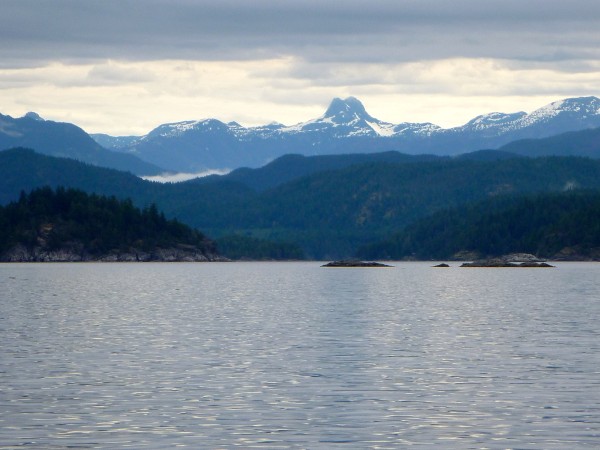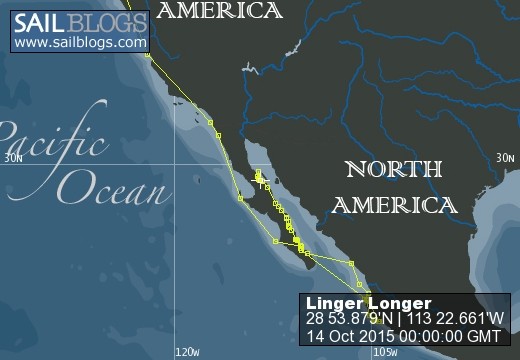
Linger Longer
14 September 2016
06 August 2016
09 July 2016
19 March 2016
19 December 2015
18 December 2015
18 December 2015
03 November 2015
18 July 2015
24 May 2015
04 April 2015
31 March 2015
26 February 2015
15 February 2015 | Barra de Navidad
07 February 2015 | Tenacatita Bay
04 February 2015
26 January 2015 | 19 18.051'N
04 January 2015 | La Cruz, Nayarit, Mexico
25 December 2014 | La Paz, Baja California Sur, Mexico
01 December 2014 | Ensenada, Mexico
Reflections by Kirk - November 26, 2015
18 December 2015
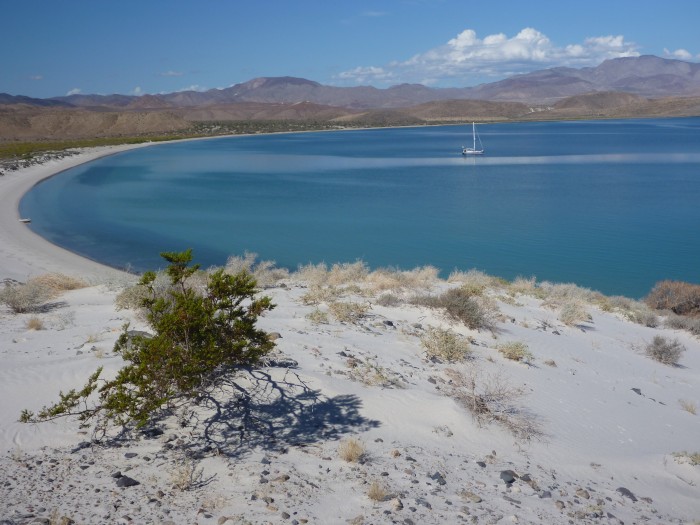
(Photo: Only boat at Ensenada Alcatraz north of Bahia de Los Angeles)
So many may wonder what it is like to live on a boat during a hot humid summer in a remote part of the Sea of Cortez (or Gulf of California as it was called when I was younger). It was hot and humid enough that sweating was a constant of life. Sweat has its good and bad sides. Sweating was essential in helping us cool our bodies. That is good. Sweating also meant that our bodies were always wet with stuff that makes armpits stinky and can leave rashes on various parts of the body. We frequently had pink spots on our arms and legs. It would take very little to make hands get those soaked-in-water wrinkles. The palms of our hands always looked like they were rotting away, but I think that was just callouses getting soft. When getting ready for bed at night, we had to hang all of our clothing as some part or all of every piece would still be wet with sweat. It may sound difficult, but it is something that we just learned to deal with. There was not much of an option.
An air conditioner was not a consideration for us as the electrical demands of an AC unit are more than we could provide. So we had fans, little seven-inch fans in every place that we spent much time. Air moving over a wet or damp body can really provide cooling relief. We only figured out how to rig up one fan in the V berth, where we would both normally sleep. If we aimed it down the middle, neither one of us got enough air, so I ended up sleeping on a long bench seat in the salon so Kris could get full force of the V-berth fan and I could direct salon fans to myself. Weird not to be sleeping together for so many weeks, but it was the only way for us both to sleep comfortably. It worked.
Shade was absolutely essential. Surface temperatures of things like skin can be as much as 20 degrees cooler in the shade. We have a dodger and bimini permanently attached to the boat. The dodger has a canvas type ceiling and clear windows below that cover the area above and around the companionway (entrance to the inside parts of the boat) supported by a stainless steel tubing frame. This extends a ways over the forward part of the cockpit area. Over the aft portion of the cockpit we have another stainless steel framework that is also covered with canvas called a bimini. There is also another piece of canvas that we can zip between the dodger and bimini so that we have a complete canvas ceiling over the entire cockpit that is firmly attached and keeps the canvas nice and taut. We spend a lot of time there. Up north in the Pacific Northwest, this was essential for us to have an outside "porch" during frequent rainy times and equally essential down here to hang out in the shade. We have several other pieces of shade cloth such that we can cover the entire boat and even have netting hanging down the sides to a provide nearly a one hundred percent shade envelope. This shade material is rather loosely attached and can be a problem in high winds. We always have the cockpit covered and erect other portions of the shade system depending on how long we plan to stay in one place, how strong the winds are forecast to be, or whether or not there may be clouds to help protect from the sun. Other than the cockpit canvas all the rest must come down and be stowed every night due to the possibility of very strong thunderstorm induced winds.
Our water tanks are below water level and the water in them was always about the same as the seawater temperature, somewhere in the upper eighties. We missed the tap water from our Redmond, Washington house in which water temps never rose above sixty degrees. We kept a few bottles of water in the fridge and always had cans (yes, cans) of beer staying cold as well. Cold beverages were treated like gold. Speaking of the fridge, it worked much harder than we anticipated and was by far the largest drain on our batteries, maybe as much as ninety percent. This will cause us to consider having a new refrigeration system installed this winter, at least a serious tune up.
We would wear as little clothing as possible while still maintaining some sense of decency when required. Cotton seemed to work best. We both tried some of the new "wonder" synthetic fabrics, but cotton still worked best. As a matter of fact, my old thread bare T-shirts that Kris has been after me to discard, were the best of all. It would seem that laundry should have been at a minimum, but no. With all of the sweat, things would get salt stained and smelly and not much could be worn more than once.
Physical activities would generally be planned for morning hours before ten o'clock or so. If I could work on something in the shade of the cockpit, it might be an afternoon project. Trips into the village or walks on the beach were best in the AM, but often ended up being PM missions and that was usually OK. In following local custom, I would frequently take an afternoon siesta. We would try to plan meals that did not involve use of the stovetop as it released so much heat into the boat. Use of the oven was a real mistake. Salads, ceviche and barbecued foods (we have a propane barbecue mounted on the stern rail) would be the choice as much as possible. When anchored near the village we would also eat ashore sometimes. Seldom would we eat three meals a day. It was just too hot to eat much. I know that may sound silly, but that is what happened with us.
Communication with the "outside" world was interesting. The only method really reliable was email through our SSB radio system. As a refresher to previous Reflections, this is a long distance radio setup that bounces radio waves off of the atmosphere and back down to earth. This system is only usable during certain times during any 24-hour period due to different properties of the atmosphere, that we need to bounce radio waves off of, during different parts of the day. There were a few landlines in the small village that we could have used, but they charged by the minute. Occasionally, a WIFI signal would be available at Guillermo's Restaurant in the village, but it was really slow and only good enough to maybe download emails from our regular computer email accounts. Many times it was too slow to get replies back out. So we missed the end of baseball season, the first third of football season and all of the entertainment of presidential election politics. Turns out that the Seahawks played poorly and the Mariners even worse, so we did not miss much there. It does sound as though the Republicans did provide good entertainment, but little of substance. During the rest of the presidential election process, we will be in and out of areas with Internet access and we will miss most of it, much to my dismay. It seems that we may be coming up on one of the more interesting races in a while. We did have one difficult, interesting and ultimately satisfying experience that involved long distance communications. Our dingy, which would be the equivalent of the family station wagon, developed a terminal problem. It is built around a high-pressure inflatable floor, which developed an irreparable leak. Life without a dinghy means that we have no good way to go from boat to shore, i.e. no grocery shopping. We had been fighting this problem for a few weeks, when a man in a kayak visited us while anchored in front of the village. He had a friend who had a friend who might be able to help us. The next day he came back with a name and an email address. The shortened version of this episode is that we were able to order a replacement floor, have it shipped to a man in San Diego, who would deliver it to another man who would be driving down to the BLA area. Not being able to use a telephone and relying on the SSB email system made for a lengthy, but ultimately successful, resolution to our problem. Living in such a remote place had its challenges, but that is part of what made it so interesting and fun.
Shopping, as always, in Mexico is an adventure. There were actually several small stores and a few larger ones where we could buy groceries and beverages. The large stores, with maybe as much floor space as a large 7-11, had a reasonably nice selection of products as long as one does not insist on eating like an American. All of the meat and poultry products were frozen and the once-a-week truck with fresh produce came in on Friday nights, so the big store was busy on Saturdays. There we could get some meat, fresh produce, canned goods, snack food, breakfast cereal, eggs, etc. All of what we wanted was never all in one place. So we dingy to shore and get whatever we can from the big store then take it all back to the boat. It was just too much to carry around one load of stuff, in all of the heat, while trekking to the other stores for the rest of what we needed. Sometimes we would dinghy right back in for another round of shopping or sometimes just do it manana. It worked out just fine and we did eat an awful lot of fresh fish.
There are a number of nice anchorages within a days sail of the village, so we never ventured more than a day away from there. One of the anchorages is known as one of the best "hurricane holes" in the Sea of Cortez. That is why we stayed in the same general area from late July to mid October. We set a personal record of 95 consecutive days without being tied to a dock. The experience taken as a whole was wonderful, but we are ready to spend some time in the big city of La Paz again for at least a week or two and are currently on our way back in that direction. Staying true to the name of the boat, we expect that it will take us around six weeks to travel the 400 miles getting there. We could have been there a little faster, but one of the unexpected things that can happen did happen. We had just left Santa Rosalia, the first place with cell coverage and decent Internet service for us in months. About one day away from Santa Rosalia we received an urgent email. The net result was that we had to have an important document notarized. This is a much larger dilemma than one would suppose it to be. There are very few notaries in Mexico who can witness and stamp a document acceptable in the United States. So we had to turn around and go back to Santa Rosalia, which has a bus station and hop on a bus to San Diego. This is a 17-hour ordeal that ends up depositing us at the US/Mexico border in Tijuana, where we have a bit of a walk to get through Customs and Immigration. The good news is that right at the US side of the border is a light rail system that can take us directly into downtown San Diego. We ended up spending a few days in San Diego before doing a repeat of the bus trip back to our boat. Who could ever even guess that an exercise such as that could possibly be required just to have someone witness a signature? But it is what it is.
Kirk
So many may wonder what it is like to live on a boat during a hot humid summer in a remote part of the Sea of Cortez (or Gulf of California as it was called when I was younger). It was hot and humid enough that sweating was a constant of life. Sweat has its good and bad sides. Sweating was essential in helping us cool our bodies. That is good. Sweating also meant that our bodies were always wet with stuff that makes armpits stinky and can leave rashes on various parts of the body. We frequently had pink spots on our arms and legs. It would take very little to make hands get those soaked-in-water wrinkles. The palms of our hands always looked like they were rotting away, but I think that was just callouses getting soft. When getting ready for bed at night, we had to hang all of our clothing as some part or all of every piece would still be wet with sweat. It may sound difficult, but it is something that we just learned to deal with. There was not much of an option.
An air conditioner was not a consideration for us as the electrical demands of an AC unit are more than we could provide. So we had fans, little seven-inch fans in every place that we spent much time. Air moving over a wet or damp body can really provide cooling relief. We only figured out how to rig up one fan in the V berth, where we would both normally sleep. If we aimed it down the middle, neither one of us got enough air, so I ended up sleeping on a long bench seat in the salon so Kris could get full force of the V-berth fan and I could direct salon fans to myself. Weird not to be sleeping together for so many weeks, but it was the only way for us both to sleep comfortably. It worked.
Shade was absolutely essential. Surface temperatures of things like skin can be as much as 20 degrees cooler in the shade. We have a dodger and bimini permanently attached to the boat. The dodger has a canvas type ceiling and clear windows below that cover the area above and around the companionway (entrance to the inside parts of the boat) supported by a stainless steel tubing frame. This extends a ways over the forward part of the cockpit area. Over the aft portion of the cockpit we have another stainless steel framework that is also covered with canvas called a bimini. There is also another piece of canvas that we can zip between the dodger and bimini so that we have a complete canvas ceiling over the entire cockpit that is firmly attached and keeps the canvas nice and taut. We spend a lot of time there. Up north in the Pacific Northwest, this was essential for us to have an outside "porch" during frequent rainy times and equally essential down here to hang out in the shade. We have several other pieces of shade cloth such that we can cover the entire boat and even have netting hanging down the sides to a provide nearly a one hundred percent shade envelope. This shade material is rather loosely attached and can be a problem in high winds. We always have the cockpit covered and erect other portions of the shade system depending on how long we plan to stay in one place, how strong the winds are forecast to be, or whether or not there may be clouds to help protect from the sun. Other than the cockpit canvas all the rest must come down and be stowed every night due to the possibility of very strong thunderstorm induced winds.
Our water tanks are below water level and the water in them was always about the same as the seawater temperature, somewhere in the upper eighties. We missed the tap water from our Redmond, Washington house in which water temps never rose above sixty degrees. We kept a few bottles of water in the fridge and always had cans (yes, cans) of beer staying cold as well. Cold beverages were treated like gold. Speaking of the fridge, it worked much harder than we anticipated and was by far the largest drain on our batteries, maybe as much as ninety percent. This will cause us to consider having a new refrigeration system installed this winter, at least a serious tune up.
We would wear as little clothing as possible while still maintaining some sense of decency when required. Cotton seemed to work best. We both tried some of the new "wonder" synthetic fabrics, but cotton still worked best. As a matter of fact, my old thread bare T-shirts that Kris has been after me to discard, were the best of all. It would seem that laundry should have been at a minimum, but no. With all of the sweat, things would get salt stained and smelly and not much could be worn more than once.
Physical activities would generally be planned for morning hours before ten o'clock or so. If I could work on something in the shade of the cockpit, it might be an afternoon project. Trips into the village or walks on the beach were best in the AM, but often ended up being PM missions and that was usually OK. In following local custom, I would frequently take an afternoon siesta. We would try to plan meals that did not involve use of the stovetop as it released so much heat into the boat. Use of the oven was a real mistake. Salads, ceviche and barbecued foods (we have a propane barbecue mounted on the stern rail) would be the choice as much as possible. When anchored near the village we would also eat ashore sometimes. Seldom would we eat three meals a day. It was just too hot to eat much. I know that may sound silly, but that is what happened with us.
Communication with the "outside" world was interesting. The only method really reliable was email through our SSB radio system. As a refresher to previous Reflections, this is a long distance radio setup that bounces radio waves off of the atmosphere and back down to earth. This system is only usable during certain times during any 24-hour period due to different properties of the atmosphere, that we need to bounce radio waves off of, during different parts of the day. There were a few landlines in the small village that we could have used, but they charged by the minute. Occasionally, a WIFI signal would be available at Guillermo's Restaurant in the village, but it was really slow and only good enough to maybe download emails from our regular computer email accounts. Many times it was too slow to get replies back out. So we missed the end of baseball season, the first third of football season and all of the entertainment of presidential election politics. Turns out that the Seahawks played poorly and the Mariners even worse, so we did not miss much there. It does sound as though the Republicans did provide good entertainment, but little of substance. During the rest of the presidential election process, we will be in and out of areas with Internet access and we will miss most of it, much to my dismay. It seems that we may be coming up on one of the more interesting races in a while. We did have one difficult, interesting and ultimately satisfying experience that involved long distance communications. Our dingy, which would be the equivalent of the family station wagon, developed a terminal problem. It is built around a high-pressure inflatable floor, which developed an irreparable leak. Life without a dinghy means that we have no good way to go from boat to shore, i.e. no grocery shopping. We had been fighting this problem for a few weeks, when a man in a kayak visited us while anchored in front of the village. He had a friend who had a friend who might be able to help us. The next day he came back with a name and an email address. The shortened version of this episode is that we were able to order a replacement floor, have it shipped to a man in San Diego, who would deliver it to another man who would be driving down to the BLA area. Not being able to use a telephone and relying on the SSB email system made for a lengthy, but ultimately successful, resolution to our problem. Living in such a remote place had its challenges, but that is part of what made it so interesting and fun.
Shopping, as always, in Mexico is an adventure. There were actually several small stores and a few larger ones where we could buy groceries and beverages. The large stores, with maybe as much floor space as a large 7-11, had a reasonably nice selection of products as long as one does not insist on eating like an American. All of the meat and poultry products were frozen and the once-a-week truck with fresh produce came in on Friday nights, so the big store was busy on Saturdays. There we could get some meat, fresh produce, canned goods, snack food, breakfast cereal, eggs, etc. All of what we wanted was never all in one place. So we dingy to shore and get whatever we can from the big store then take it all back to the boat. It was just too much to carry around one load of stuff, in all of the heat, while trekking to the other stores for the rest of what we needed. Sometimes we would dinghy right back in for another round of shopping or sometimes just do it manana. It worked out just fine and we did eat an awful lot of fresh fish.
There are a number of nice anchorages within a days sail of the village, so we never ventured more than a day away from there. One of the anchorages is known as one of the best "hurricane holes" in the Sea of Cortez. That is why we stayed in the same general area from late July to mid October. We set a personal record of 95 consecutive days without being tied to a dock. The experience taken as a whole was wonderful, but we are ready to spend some time in the big city of La Paz again for at least a week or two and are currently on our way back in that direction. Staying true to the name of the boat, we expect that it will take us around six weeks to travel the 400 miles getting there. We could have been there a little faster, but one of the unexpected things that can happen did happen. We had just left Santa Rosalia, the first place with cell coverage and decent Internet service for us in months. About one day away from Santa Rosalia we received an urgent email. The net result was that we had to have an important document notarized. This is a much larger dilemma than one would suppose it to be. There are very few notaries in Mexico who can witness and stamp a document acceptable in the United States. So we had to turn around and go back to Santa Rosalia, which has a bus station and hop on a bus to San Diego. This is a 17-hour ordeal that ends up depositing us at the US/Mexico border in Tijuana, where we have a bit of a walk to get through Customs and Immigration. The good news is that right at the US side of the border is a light rail system that can take us directly into downtown San Diego. We ended up spending a few days in San Diego before doing a repeat of the bus trip back to our boat. Who could ever even guess that an exercise such as that could possibly be required just to have someone witness a signature? But it is what it is.
Kirk
Comments
| Vessel Name: | S/V Linger Longer |
| Vessel Make/Model: | Sceptre 41/43 |
| Hailing Port: | Seattle, WA |
| Crew: | Kirk & Kristin Doyle |
| Extra: | |
| Home Page: | http://www.k2doyle.com |
S/V Linger Longer's Photos - Main
|
Heading north into the Sea of Cortez for the summer where there is less change of hurricanes.
72 Photos
Created 19 December 2015
|
Who: Kirk & Kristin Doyle
Port: Seattle, WA
